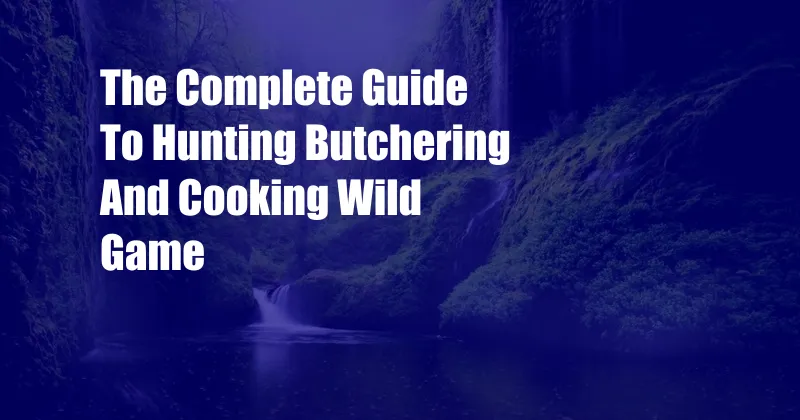
The Complete Guide to Hunting, Butchering, and Cooking Wild Game
As an avid outdoorsman, I’ve always been fascinated by the thrill of hunting and the satisfaction of preparing and eating wild game. From the adrenaline rush of the chase to the delectable flavors of venison and wild turkey, the experience is truly unparalleled. In this comprehensive guide, I will embark on an immersive journey through the world of hunting, butchering, and cooking wild game so that you too can master this ancient art.
Hunting has been an integral part of human history, providing sustenance and resources for centuries. Today, hunting remains a popular pastime, offering challenges, camaraderie, and a deep connection to nature. Whether you’re a seasoned hunter or a novice, understanding the basics of hunting is essential for a successful and ethical experience.
Hunting Techniques
The hunting method you choose will depend on the species you’re pursuing and the environment you’re hunting in. Some common techniques include:
- Still hunting: This involves moving quietly through the woods, scanning for game.
- Stalking: This involves cautiously approaching game from downwind.
- Tracking: This involves following game tracks to find and pursue it.
- Stand hunting: This involves sitting in a tree stand or blind, waiting for game to come within range.
Butchering is the process of cutting up game after it’s been harvested. This requires specialized knowledge and skills to ensure the meat is safe and edible. Here are the steps involved:
Butchering Techniques
The butchering process may vary depending on the species of game, but the general steps include:
- Dressing: Remove the internal organs and any inedible parts.
- Skinning: Remove the skin from the meat.
- Quartering: Cut the meat into manageable pieces.
- Boning: Remove the bones from the meat.
- Trimming and packaging: Trim away excess fat and package the meat in airtight containers for storage.
Cooking wild game is similar to cooking other types of meat, but there are some key things to keep in mind:
Cooking Techniques
Wild game tends to be leaner than domestic meat, so it’s important to cook it carefully to avoid drying it out. Here are some tips:
- Barding: Wrap the meat in bacon or fat to add moisture.
- Marinating: Soak the meat in a flavorful marinade to tenderize it.
- Braising: Cook the meat slowly in a liquid to keep it moist.
- Roasting: Cook the meat in a hot oven to create a flavorful crust while maintaining juiciness.
In addition to the basics, staying up-to-date on the latest trends and developments related to hunting, butchering, and cooking wild game is essential. Attend hunting seminars, read industry publications, and connect with fellow outdoorsmen and women through forums and social media platforms to stay informed.
Finally, while hunting, butchering, and cooking wild game can be incredibly rewarding, it’s important to remember the ethical implications. Always follow hunting regulations, respect wildlife, and prioritize safety to ensure a sustainable and enjoyable experience.
FAQs on Hunting, Butchering, and Cooking Wild Game
Q: What are the most common types of game hunted in the United States?
A: Deer, turkey, elk, bear, and rabbits are some of the most popular game species in the U.S.
Q: How do I choose the right hunting weapon?
A: The best hunting weapon for you will depend on the species you’re hunting, the terrain you’re hunting in, and your personal preferences.
Q: What’s the best way to store wild game meat?
A: Store wild game meat in airtight containers in the refrigerator for up to 3 days or in the freezer for up to 6 months.
Q: How do I know if wild game meat is safe to eat?
A: Always cook wild game meat to an internal temperature of 165 degrees Fahrenheit to ensure it’s safe to eat.
Q: What are some delicious ways to cook venison?
A: Venison can be cooked in a variety of ways, such as grilling, roasting, braising, or making jerky. You can also be creative and try different marinades and recipes to enhance the flavor.
Q: Is hunting an ethical practice?
A: Hunting can be an ethical practice if it’s done in accordance with hunting regulations, respects wildlife, and prioritizes safety. It’s important to remember that hunting should be done for sustenance or responsible wildlife management, not just for sport.
Conclusion:
The pursuit of hunting, butchering, and cooking wild game is a rich and rewarding experience that connects us to nature, tradition, and the food we eat. By mastering the techniques outlined in this guide, you can become a skilled outdoorsman or woman, ensuring a safe, ethical, and delicious experience. Whether you’re a seasoned hunter or just curious about the world of wild game, I encourage you to explore this fascinating topic further. From the thrill of the chase to the satisfaction of cooking and eating your own harvest, the journey into the world of wild game is one that will undoubtedly leave a lasting impression.
Are you interested in learning more about hunting, butchering, or cooking wild game? Share your thoughts, questions, or experiences in the comments below!